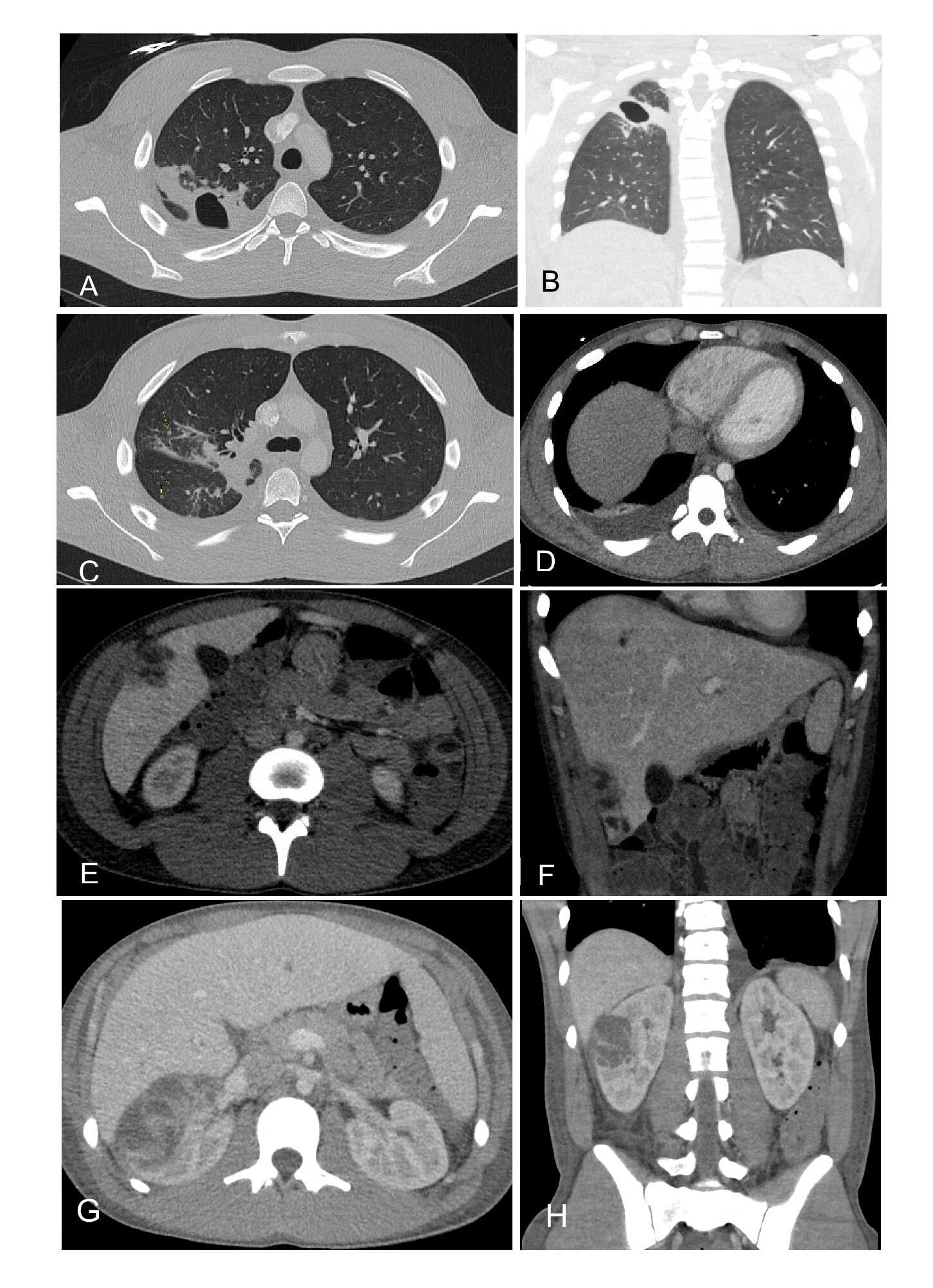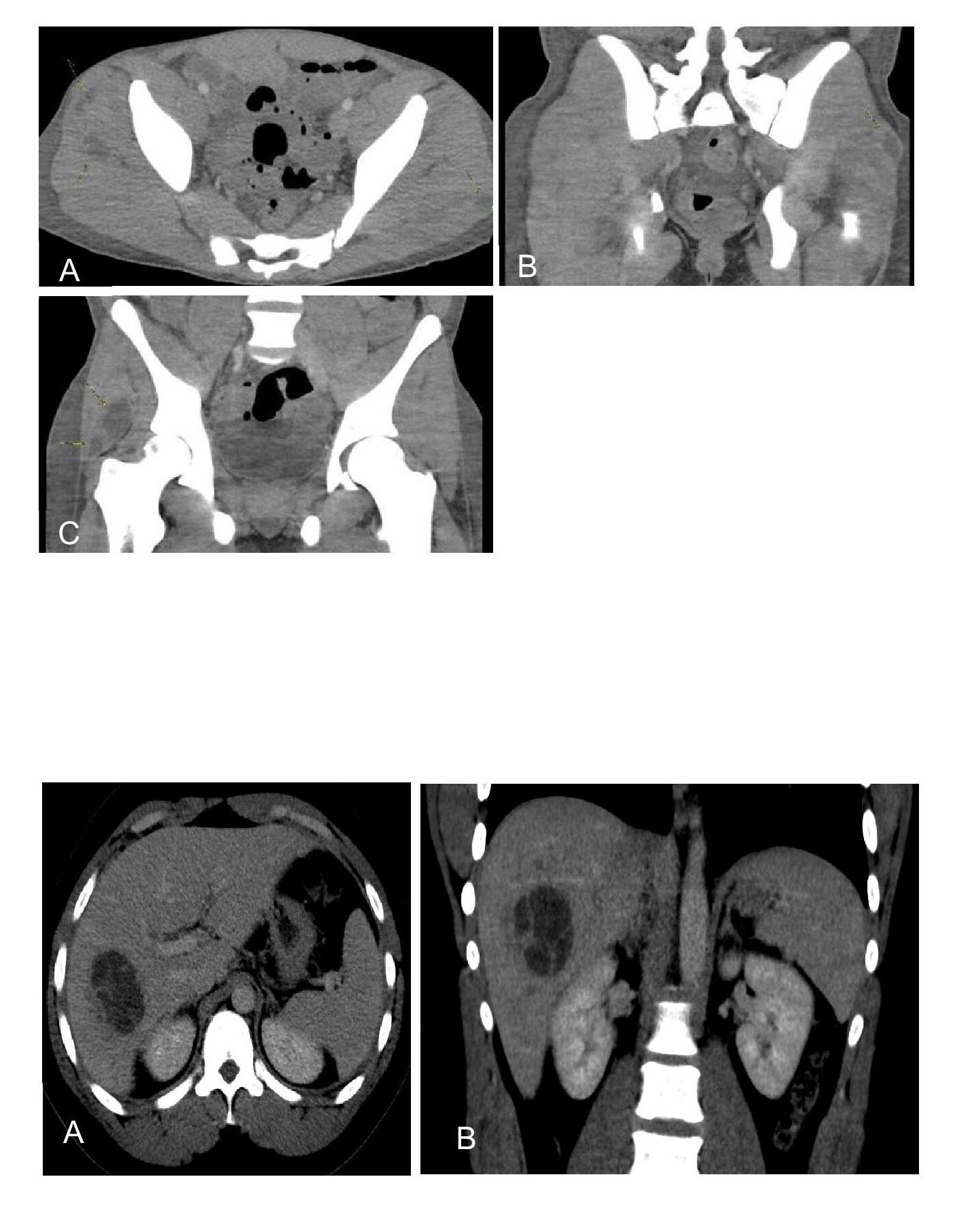Monday Poster Session
Category: Infections and Microbiome
Cryptogenic <i>Fusobacterium</i> Liver Abscesses in Two Healthy, Young Adult Males
P3484 - Cryptogenic Fusobacterium Liver Abscesses in Two Healthy, Young Adult Males
Monday, October 27, 2025
10:30 AM - 4:00 PM PDT
Location: Exhibit Hall

Cooper A. Josephs, DO (he/him/his)
Memorial Health University Medical Center
Savannah, GA
Presenting Author(s)
Cooper A. Josephs, DO, Anna Bryce Tucker, BS, James Everhart, DO, Taylor Templeton-Jager, PhD, Nicholas Fuerstenau, MD
Memorial Health University Medical Center, Savannah, GA
Introduction: Fusobacterium necrophorum and Fusobacterium nucleatum rarely are responsible for bacterial human infections. However, when Fusobacterium necrophorum causes pyogenic liver abscesses (PLAs), it is infamously found in Lemiere’s syndrome, which encompasses internal jugular vein thrombophlebitis and septicemia. This report documents two cases of cryptogenic Fusobacterium liver abscesses in healthy, young adult males with a history of binge drinking, but without concomitant Lemiere’s syndrome. We highlight key differences in disease severity, bacterial species, and management between the two cases.
Case Description/
Methods: Both patients lived in similar geographic regions and presented to the hospital a month apart from one another. Patient 1 was a 19-year-old Caucasian male who arrived with fever and abdominal pain. He developed bacterial metastasis with abscess formation in the right kidney, gluteal muscles, liver, and right upper lung. He received percutaneous-guided needle aspiration of the renal abscess and was discharged on IV antibiotics. Patient 2 was a 20-year-old African American male with similar symptoms as patient 1. He developed a singular hepatic abscess and underwent percutaneous catheter drain placement by general surgery. The drain remained in for several days, and the patient was discharged with PO antibiotics. Both patients made complete recoveries.
Discussion: It is hypothesized that both infections developed in part through aspiration of oral flora secondary to alcohol intoxication. Given the similarities in patient geography and hospitalization dates coupled to its rarity, this may be a growing issue that public healthcare leaders should be aware if future cases arise. It is important to consider Fusobacterium species in Pyogenic Liver Abscess (PLAs) in young men with alcohol use. PLA source control may play an important role even with an abscess less than 3-5 cm. Further research needs to be conducted to determine if Fusobacterium necrophorum and Fusobacterium nucleatum are associated with alcohol and/or binge drinking.

Figure: Figure 1: CT scans. Chest (axial and coronal) demonstrating region of consolidation with internal cavitation in the posterior right upper lobe (a, b). Scattered pulmonary micronodules within the right upper and superior right lower lobe (axial with lung window) (c). Small bilateral pleural effusions, right greater than left, with compressive atelectasis (axial) (d). Multiple hypodense hepatic lesions with subtle rim enhancement with reference lesion in the inferior right hepatic lobe, favored to reflect hepatic abscesses (axial with liver window) (e). CT abdomen (coronal with liver window) (f). Heterogeneous, hypoattenuating mass arising from the right renal midpole, favored to represent pyelonephritis with evolving renal abscess (axial and coronal) (g, h).

Figure: Figure 2: CT pelvis (axial) - multilocular rim-enhancing fluid collection insinuated throughout the right gluteus minimus and medius musculature, concerning for an abscess. There is also concern for an abscess in the left gluteus medius (a). CT pelvis (coronal) - abscesses on the right (b). CT pelvis (coronal) - abscess on the left (c). Figure 3: CT abdomen (axial with liver window) - hypodense lesion within the right hepatic lobe concerning for an abscess. A) Axial liver window. B) Coronal liver window.
Disclosures:
Cooper Josephs indicated no relevant financial relationships.
Anna Bryce Tucker indicated no relevant financial relationships.
James Everhart indicated no relevant financial relationships.
Taylor Templeton-Jager indicated no relevant financial relationships.
Nicholas Fuerstenau indicated no relevant financial relationships.
Cooper A. Josephs, DO, Anna Bryce Tucker, BS, James Everhart, DO, Taylor Templeton-Jager, PhD, Nicholas Fuerstenau, MD. P3484 - Cryptogenic <i>Fusobacterium</i> Liver Abscesses in Two Healthy, Young Adult Males, ACG 2025 Annual Scientific Meeting Abstracts. Phoenix, AZ: American College of Gastroenterology.
Memorial Health University Medical Center, Savannah, GA
Introduction: Fusobacterium necrophorum and Fusobacterium nucleatum rarely are responsible for bacterial human infections. However, when Fusobacterium necrophorum causes pyogenic liver abscesses (PLAs), it is infamously found in Lemiere’s syndrome, which encompasses internal jugular vein thrombophlebitis and septicemia. This report documents two cases of cryptogenic Fusobacterium liver abscesses in healthy, young adult males with a history of binge drinking, but without concomitant Lemiere’s syndrome. We highlight key differences in disease severity, bacterial species, and management between the two cases.
Case Description/
Methods: Both patients lived in similar geographic regions and presented to the hospital a month apart from one another. Patient 1 was a 19-year-old Caucasian male who arrived with fever and abdominal pain. He developed bacterial metastasis with abscess formation in the right kidney, gluteal muscles, liver, and right upper lung. He received percutaneous-guided needle aspiration of the renal abscess and was discharged on IV antibiotics. Patient 2 was a 20-year-old African American male with similar symptoms as patient 1. He developed a singular hepatic abscess and underwent percutaneous catheter drain placement by general surgery. The drain remained in for several days, and the patient was discharged with PO antibiotics. Both patients made complete recoveries.
Discussion: It is hypothesized that both infections developed in part through aspiration of oral flora secondary to alcohol intoxication. Given the similarities in patient geography and hospitalization dates coupled to its rarity, this may be a growing issue that public healthcare leaders should be aware if future cases arise. It is important to consider Fusobacterium species in Pyogenic Liver Abscess (PLAs) in young men with alcohol use. PLA source control may play an important role even with an abscess less than 3-5 cm. Further research needs to be conducted to determine if Fusobacterium necrophorum and Fusobacterium nucleatum are associated with alcohol and/or binge drinking.

Figure: Figure 1: CT scans. Chest (axial and coronal) demonstrating region of consolidation with internal cavitation in the posterior right upper lobe (a, b). Scattered pulmonary micronodules within the right upper and superior right lower lobe (axial with lung window) (c). Small bilateral pleural effusions, right greater than left, with compressive atelectasis (axial) (d). Multiple hypodense hepatic lesions with subtle rim enhancement with reference lesion in the inferior right hepatic lobe, favored to reflect hepatic abscesses (axial with liver window) (e). CT abdomen (coronal with liver window) (f). Heterogeneous, hypoattenuating mass arising from the right renal midpole, favored to represent pyelonephritis with evolving renal abscess (axial and coronal) (g, h).

Figure: Figure 2: CT pelvis (axial) - multilocular rim-enhancing fluid collection insinuated throughout the right gluteus minimus and medius musculature, concerning for an abscess. There is also concern for an abscess in the left gluteus medius (a). CT pelvis (coronal) - abscesses on the right (b). CT pelvis (coronal) - abscess on the left (c). Figure 3: CT abdomen (axial with liver window) - hypodense lesion within the right hepatic lobe concerning for an abscess. A) Axial liver window. B) Coronal liver window.
Disclosures:
Cooper Josephs indicated no relevant financial relationships.
Anna Bryce Tucker indicated no relevant financial relationships.
James Everhart indicated no relevant financial relationships.
Taylor Templeton-Jager indicated no relevant financial relationships.
Nicholas Fuerstenau indicated no relevant financial relationships.
Cooper A. Josephs, DO, Anna Bryce Tucker, BS, James Everhart, DO, Taylor Templeton-Jager, PhD, Nicholas Fuerstenau, MD. P3484 - Cryptogenic <i>Fusobacterium</i> Liver Abscesses in Two Healthy, Young Adult Males, ACG 2025 Annual Scientific Meeting Abstracts. Phoenix, AZ: American College of Gastroenterology.
